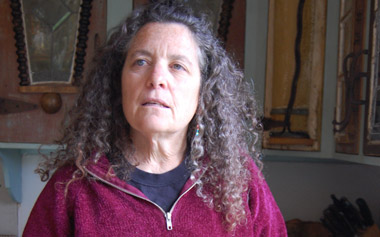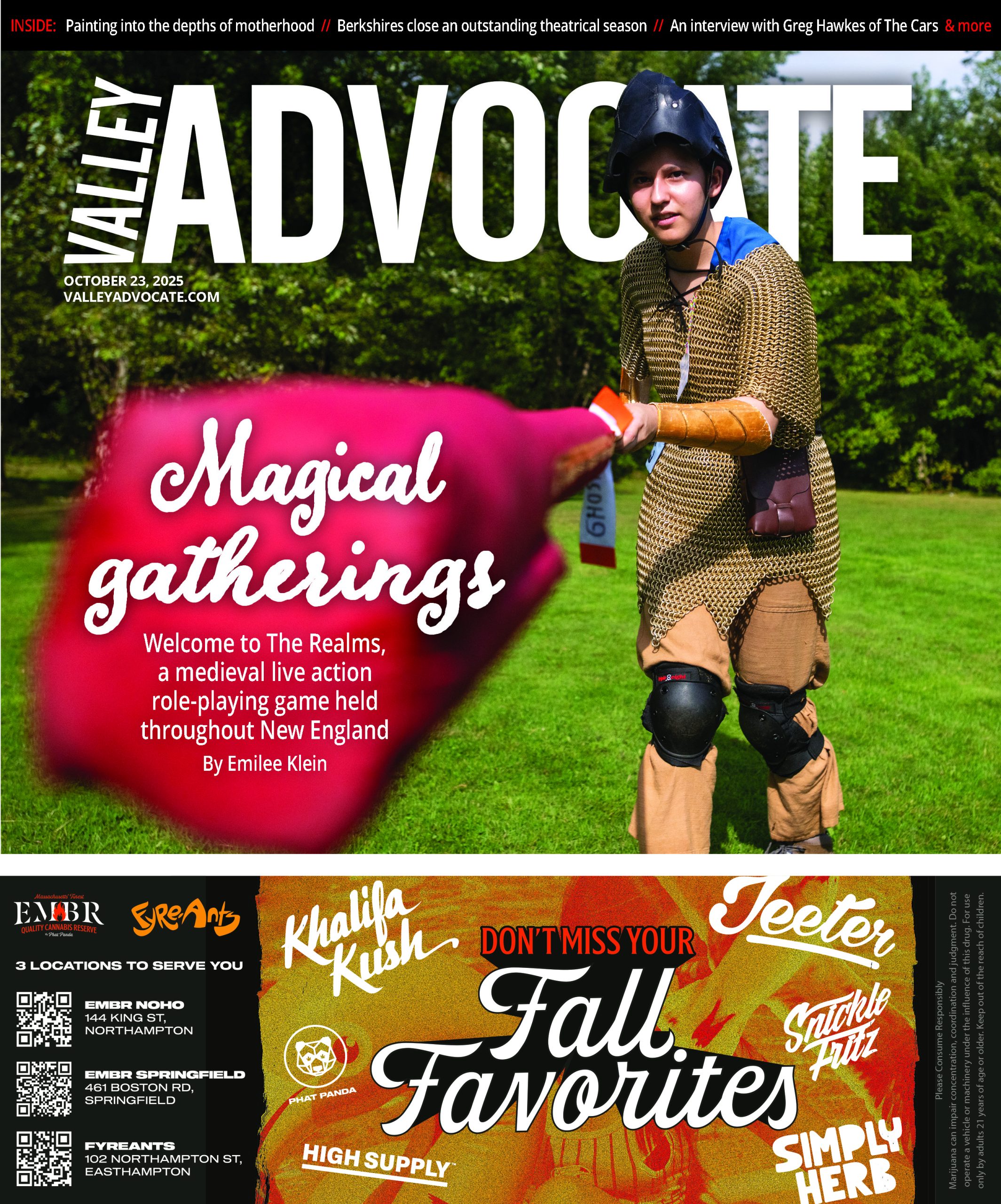“What can I do about it?”
Deep into a far-ranging discussion with Ricki Carroll, Ashfield’s internationally recognized “Cheese Queen,” she stopped upon this phrase, repeated it and declared the expression the essence of the problem the world faced and the question she forever was challenging herself to answer.
I’d been expecting to talk cheese-making in the Valley, but our conversation ventured far and wide, and it occasionally got deep and strayed into places seemingly far from her roots as a cheese evangelist who teaches traditional cheese-making techniques that can be used at home.
After 30 years running the New England Cheese Supply Company from her home on Main Street in Ashfield, Carroll recently relocated the operation to South Deerfield. In doing so, she’s handed over daily operations to her daughter Sarah and the eight other employees.
“I warned them that if we moved the business [to a more central location for the staff], they were likely to see a lot less of me,” she said. “They didn’t believe me; I used to be the one up at four in the morning making certain orders got filled. But now Sarah’s the one doing that.”
Carroll still teaches classes in her Ashfield home and remains in close contact with the artisanal cheese world, but she’s cut down the frequency with which she gives the day-long lessons, and she’s dedicated herself to spending the next couple of years letting other interests occupy some of her attention. She’s “considering her options,” she says, including possibly making a more serious commitment to local politics, which may be one of the reasons the rhetorical question resonated with her.
For years, for Ricki Carroll, the answer to “What can I do about it?” has always been simple: Make cheese and show others how.
*
The story of the Cheese Queen goes something like this.
In the early 1970s, Carroll and her then-husband, Robert, moved into a tremendous Victorian a few doors down from the Ashfield public library. She’d been an elementary school art teacher, and they moved up so he could attend UMass. Eleven people moved in, and neighbors introduced them to the wonders of raising goats.
The interest in cheese was tangential to her main concern at the time, which was what they were going to do with all the milk they were now producing. Unable to find local advice on cheese production techniques, they began writing letters to different European governments, looking for any way they might learn. This lead to several months on a farm in England that produced its own cheeses.
Back home, in her own kitchen, Ricki Carroll began giving classes on what she had learned. At first the groups were intimate, around a half dozen or so people, but they eventually grew to groups of 40 or more. Instead of emphasizing too much technique or chemistry, she took another approach in her lessons.
“More than anything, I wanted to get people excited that they could make cheese themselves,” she said. She took the mystery out of the process and showed her students what was possible in their own kitchens.
One person who took her class happened to have recently written a book on making cider. Annie Proulx’s book “rediscovered” the art of cider-making, and through explaining how to make it yourself, taught the beverage’s history and restored its heritage. Proulx recommended Carroll to her publisher as someone who could write a similar book on cheese.
The resulting book, Cheese Making Made Easy, first published in 1981, has sold over 140,000 copies. It’s now in its third edition, more than three times as long, and sold under the title Home Cheese Making. As Proulx predicted, the book became the artisan cheese-maker’s bible, and in those circles, Carroll’s royal title is taken seriously. It’s not uncommon for someone to approach her in public with stars in their eyes (probably made of Gouda) and ask in awe, “Are you the Cheese Queen?”
*
Even if you have no interest in making cheese for yourself, the book is an engaging—exciting even—introduction to the world of a common favorite food. If you’ve ever wondered what the difference was between two different kind of cheeses or exactly what makes vegetarians squeamish about plain old cheddar, the book will open your eyes. In less than forty well-illustrated pages, Carroll outlines the basics—ingredients, equipment and techniques—and the rest of the book contains recipes for six different kinds of cheeses (soft, hard, Italian, whey, mold-ripened, and goat’s milk cheeses) and also other dairy products, such as sour cream and yoghurt.
Her prose style is friendly, sometimes funny, but always matter-of-fact and refreshingly void of bullshit.
While the book secured her fame, it was the cheese-making supply that secured Carroll her fortune. Just as she had to turn to European cheese-makers to learn her art, supplies for making cheese at home were not readily available in America, and to get the cheapest prices for herself, she ordered in bulk from these distant countries, took what she needed and sold the rest.
“I was attending [an early meeting of the] American Cheese Society a few years after the book came out. I began to realize that a lot of small American cheese-makers were really limited in what they could make by the ingredients and equipment we were importing and selling,” she said. “It was really eye-opening for me.” Afterwards, the company focused on expanding its offerings and trying to offer as much diversity as possible.
She remembers that when they initially began ordering huge two-ton blocks of wax from Holland used to encase cheeses while they mature, they had no idea how to divide the blocks. They first used a buzz saw.
“It sent wax shards flying everywhere,” she said. “It was a total mess, but it got the job done. It took us a few years to figure out you could slice it with wire—and it didn’t even need to be heated.”
For a while the business began selling bigger equipment—like British milking equipment and large cheese-making vats from the Dutch—but Carroll deliberately has returned the supply company’s attention to serving the smaller-scale, artisan makers. Still, even with the narrowed focus, her influence has been felt far and wide, and on a small and large scale.
Over 30 years ago, Samuel Kamen of Stonyfield Farms attended a class, and Carroll says it was her ex-husband who suggested that instead of cheese, they perhaps make yoghurt. In 2007, author Barbara Kingsolver took a class and wrote about the Cheese Queen in her bestseller, Animal, Vegetable, Miracle, and Carroll said her business doubled in three weeks.
*
The Cheese Queen’s favorite customer, though, seems to have always been the person who didn’t think they could possibly make cheese themselves at home. She and her staff still delight in hearing from people all over the globe who have discovered that they, too, can partake in an art that’s been a central delight of eaters for over 10,000 years.
She’s not bashful about why she thinks people have lost contact with how to make cheese.
She says that over the last century or so, the government has supported a corporate culture that has created an appetite for and dependency on blandly consistent food produced cheaply on a monolithic scale. Further, our legislators have written laws that make it difficult—if not impossible—for small dairy farmers to produce the kinds of value-added products that have sustained them for as long as people have been eating cheese.
“Americans make and eat dead food,” she said.
One of the Supply Company’s biggest sellers is the 30 Minute Mozzarella Basic Cheese Kit, which, as the product name suggests, supplies customers with what they need to make their own pizza-worthy mozzarella in less than an hour. For decades, the product has been a sure-fire hit, but lately they’ve been getting reports that in some cases the cheese doesn’t cling. When this has happened before, the culprit has usually been ultra-pasteurized milk—milk heated to a higher temperature than regulated as necessary to kill potentially harmful bacteria. It’s something she warns about in her literature.
“More and more, though,” she said, “it seems milk producers aren’t being clear about what levels of pasteurization they’re using, and it’s not labeled clearly.”
Getting rid of bacteria may sound like a good thing, but pasteurization also kills the kinds of micro-organisms that make cheese possible. What historically started as a process to keep beer fresh was later applied to milk, a beverage that was, prior to industrialization, generally consumed fresh to begin with. Old raw milk was turned into dairy products like cheese. Low-levels of pasteurization will still produce a milk that can be used, but the best cheeses have always been made from raw milk, and the government is considering mandating heating the milk to an even higher temperature. (For a review of locally produced raw milk and cheeses, see this week’s “Udderly Delicious” in the food section.)
High levels of pasteurization, Carroll maintains, are generally permitted not so much to keep people healthy as to mask the poor treatment of the animals on large-scale operations.
“What’s called “fresh” these days can be produced in one state, pasteurized in a different state, and then pasteurized again somewhere else,” Carroll said. “Look at the expiration date sometime. If it’s weeks or months ahead, what you’ve basically got is white water.” It’s been killed and bleached, she said. “Raw milk is supposed to be slightly yellow.”
Still, while government food agencies don’t require specificity about the rates of pasteurization, they can be militant about upholding laws about consuming raw milk. In Massachusetts, for instance, it’s okay for a dairy to sell it on the farm, but not for them to sell it at a farmer’s market or in a store. Cheeses made from raw milk can not be sold until they’ve aged more than 60 days. Carroll says she was recently in a small artisan cheese store out West that had had a good deal of its inventory destroyed by food inspectors who questioned the age of the cheese.
Laws like these, the Cheese Queen said, are political with clear winners and losers. She loaned me a copy of The Raw Milk Revolution by David Gumpert to learn more of the conflict. To assist those that these laws harm (you and the local dairy farmer), Carroll’s supply store has begun to host on its site a list of national farms that sell cheese-friendly milk: www.cheesemaking.com/goodmilklist.html.
You don’t need to buy from a farm on the list to make cheese at home, but Carroll stresses for best results, “if given a choice, local is better than organic.”
*
Beyond cheese, Ricki Carroll has nurtured a love of song and singing. She and her partner host concerts at their home, and they regularly attend singing summer camps and workshops organized by Village Harmony, a group based in Marshfield, Vermont, but which hosts camps and courses nationally and internationally.
This winter Carroll traveled to several different singing events, including ones in South Africa and Georgia. After one of the South African concerts, Carroll connected with someone in the audience, and after explaining what she did, the South African said she must visit the dairy farm of a friend who made cheese. At first, the African cheese-maker was apprehensive about the American wanting to pry into his business, but when he discovered her royal lineage, all resistance melted. “Ah, the Cheese Queen!”
With delight, Carroll explained that the cheese-maker had been trained in Switzerland, and she described the cheese maker’s traditional copper kettle suspended over the fire on a crane that could be swung back and forth from the heat. No electric thermometers were in sight. No one could doubt what was being made there with raw materials and an artisan’s touch was anything but wholesome, healthy and delicious.
“Every American food inspector should be required to spend time on a small, foreign dairy farm,” the Cheese Queen declared.



